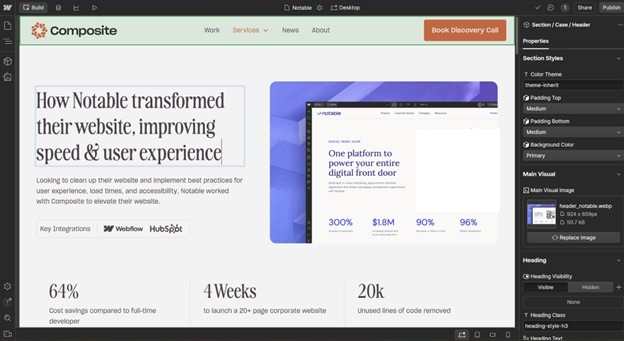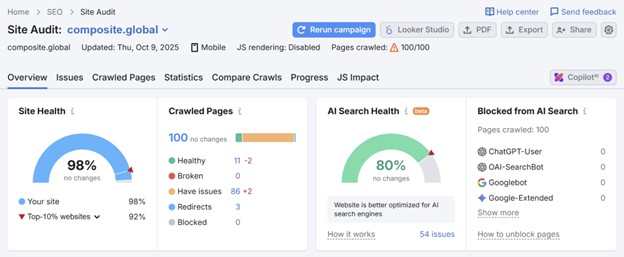Websites used to be built once and left alone. Maybe you updated the blog now and then, refreshed a hero image, or added a new product page when needed. But for AI-first startups, enterprise fintech platforms, and rapidly scaling medtech companies, that approach just doesn’t work anymore.
The rules have changed, and the best digital teams are already acting like it.
Here’s why that matters, and how to get started on future-proofing your website.

1. Design Systems Win Over Design Trends
Flashy doesn’t scale. Whether you’re a fintech API startup or a healthcare AI platform, your site has to evolve as fast as your roadmap. New products, new markets, new audiences. If your website isn’t built modularly, it becomes a bottleneck, waiting on that dev ticket to be pushed through.
That’s why smart brands are prioritizing design systems.
Instead of one-off hero sections or cobbled-together landing pages, they’re building flexible, repeatable frameworks with:
- Reusable components (think: testimonial sliders, feature blocks, pricing cards)
- CMS-driven content for blogs, careers, or gated resources
- Scalable navigation that can grow with your offering
Tools like Webflow make this easier. With visual versioning, CMS logic, and component libraries, dev and marketing teams can collaborate without stepping on each other’s toes. It’s the difference between maintaining your site and evolving it.

2. UX Isn’t Just for Humans Anymore
Good UX used to mean intuitive flows, logical nav, and a fast load time. That’s still true, but now, UX has a new stakeholder: the AI agent.
From GPT-style bots to Google’s AI Overviews to embedded enterprise assistants, your website is being interpreted and summarized by machines as often as it is by people.
If your structure is confusing or bloated, AI systems won’t be able to parse what you do or who you help. That means you won’t be recommended in summaries, answer boxes, or chatbot citations.
Enter: Agent Experience (AX)
AX is the emerging discipline of optimizing your site so AI agents can accurately retrieve, interpret, and cite your content. That means:
- Using semantic HTML and heading hierarchy
- Writing clear, structured content blocks
- Including internal links that signal relationships between content
- Adding schema markup for context
If you’ve invested in SEO, AX is your next evolution. The benefit? AI agents get smarter and you stay in the conversation.
Pro tip: Add an llms.txt file to your site. It tells language models like GPTBot, Claude, and Gemini which pages they can crawl or cite. It’s like robots.txt, but for AI. For a step-by-step guide on generating and implementing llms.txt, read our guide SEO for ChatGPT: Help LLMs Understand Your Website.
3. SEO Has Changed, But It’s Not Dead
You’ve probably seen the headlines: “SEO is dead.” It’s not. But it is changing.
Today, ranking well means more than keywords. Search engines now reward:
- Structured data and schema
- Fast page speed and mobile performance
- Clear UX and intent-matched content
- Accessible markup and semantics
That’s because Google, Bing, and others are adapting to how people (and bots) find information. And increasingly, that includes AI-generated answers based on crawlable content.
So what should you do?
- Keep writing helpful, search-optimized content.
- Invest in technical SEO like schema, alt text, clean slugs, and fast code.
- Design with structure and logic. Think blocks, not blobs.
- Focus your site around real user problems, not generic features.
4. Accessibility Is a Strategic Advantage
Many companies still treat accessibility as an afterthought, or worse, a legal box to check. But the best websites treat it as a core part of their strategy.
When your site is accessible, it performs better for everyone:
- Screen readers and keyboard users can navigate with ease
- AI crawlers can parse content more accurately
- Search engines understand your content hierarchy
And yes, it makes your brand look more professional and inclusive.
What does accessibility look like in practice?
- Proper heading structure (H1, H2, H3)
- Descriptive alt text
- High contrast and legible fonts
- Semantic HTML (not just div soup)
- ARIA labels where needed
5. Site Health = Business Health
Fintech apps crash without uptime. Medtech platforms lose trust if they lag. So why let your website be the weak link?
Every few months, check your site’s vitals:
- Broken links
- Outdated plugins or dependencies
- Excessive load times
- Mobile responsiveness issues
- Crawling errors or indexation problems
Composite recommends tools like:
- Google Search Console and PageSpeed Insights
- Microsoft Clarity for heatmaps and interaction data
- Semrush or Ahrefs for SEO and site health
- Built-in Webflow audits for performance and accessibility
Treat your site like a product. Monitor it, test it, improve it.

6. Webflow: Built for the Way You Build Now
Whether you’re a lean startup or an enterprise team, Webflow gives you design freedom without sacrificing structure. That’s why Composite uses it for nearly every project we ship—especially for clients in AI, fintech, and medtech.
Here’s why:
- Design systems made simple – Components, styles, and CMS structure all in one place.
- Visual collaboration – No more back-and-forth over static mockups.
- Built-in performance wins – Webflow outputs clean HTML/CSS/JS with fewer bloat issues.
- Faster dev time – Less time waiting on hardcoded changes, more time testing and iterating.
- SEO and accessibility features – Control meta tags, ARIA attributes, and custom schema without needing an engineering lift.
Want to see it in action? Check out how we migrated Gather AI to Webflow with performance, UX, and scalability in mind.
Build for the Next Era
Your website is your growth engine. If it’s not built for speed, structure, and intelligent discovery, it’s not built for the future.
That’s why Composite helps companies rethink their sites, not just with a new coat of paint, but with a strategic foundation that supports:
- Smart UX
- AI-readiness (AX and llms.txt)
- Modular design systems
- SEO and accessibility baked in
- Scalable platforms like Webflow
Whether you’re refreshing your messaging or overhauling your platform, it pays to build a site that’s as forward-thinking as the products you sell.